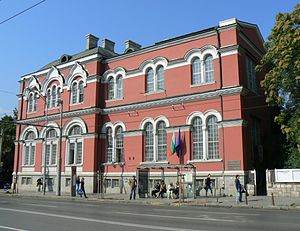The
State Drawing School was opened on 1 October 1896 by Decree signed by
Prince Ferdinand. This Act made legitimate the oldest institution for
higher education in Bulgaria. The archive documents for the setting up
of the present Academy reveal the names of outstanding public figures,
artists Anton Mitov, Ivan Markvichka and Boris Shats and men of letters
Konstantin Velichkov and Ivan Shishmanov.
In
1911 the teaching staff submitted a plan for development to the
Ministry of Education in which they also put forward their request the
School to be renamed to Academy of Art. Ten years later in 1921
following a proposal by Stoyan Omarchevski, Minister of Education, the
State Drawing School was renamed to Academy of Art.
Today
the former Drawing School is called National Academy of Art, which till
this very day is still considered to be the most prestigious Bulgarian
institution for training professional artists in the field of fine and
applied arts, design, conservation and restoration and history and
theory of art (in BA, MA and DA degrees).
The
quality maintenance system is completed hierarchical functionality of
rules, described in normative documents, regulated activities and
organizational structures. It forms the policy for achieving quality
objectives and provides planning, management, monitoring and evaluation
of the factors that determine quality of training.
Quality in this context refers only to training and academic staff and all academic entities are treated only in this aspect.
The
system for assessing and maintaining the quality of training sets
requirements to academic records through its representatives in the
academic and faculty bodies, approving academic standards, curricula,
programs and schedules for the training process.
Main targets of assessment are specialty, academic subject, lecturer, academic manager, educational qualification degree.
Specific
objects of assessment are based on the analysis of the situation and
are associated with identified weaknesses (the learning process
discipline, training, services to students, graduation, etc.).
Primary
and determining factor of quality of training is keeping students,
lecturers and academic management motivated to achieve quality.
Quality
of training is achieved through periodic assessment of the following
targets: specialty, academic subject, lecturers. The assessment is
performed in terms of the quality of the learning process (self
assessment) and the result of the training (external evaluation).
In assessing the three targets taking into account the opinion of the students is compulsory.
Students’ opinion is objectively recorder by periodically conducted surveys.
The results of the assessment of specialties, subjects and lecturers are subject to adjustable publicity.
The quality assessment and maintenance system consists of three levels:
Level 1: Academic Commission on quality of training at the Academic Council, Vice-rector for quality and administrative staff;
Level 2: Faculty Commission on quality of training;
Level 3: Departmental officer on quality of training.
Appraisal
The appraisal of academic staff is to
meet the requirements of Art. 6, para. 4 of the Higher Education Act
regarding establishing the element of the system for assessing and
maintaining the quality through:
– assessing the contribution of each
member of the faculty in academic, artistic, research and administrative
activities of the academy;
– improving the selection and qualification and stimulating creative development of lecturers;
– exploring students' opinion about the quality of education.
Subject of evaluation is each faculty member working under employment with NAA.
(2) Subject to the evaluation study are
methodical, artistic creativity, scientific research and administration
activities of the appraisee.
(3) appraisal is mandatory.
(4) According to Art. 57 of the Higher
Education Act non-habilitated persons are appraised once in three years,
and persons with academic rank – every five years.
Appraisal shall be carried out according
to published criteria that should be made available to any member of the
faculty, according to Art. 57 (2) of the Act. As pre-announced criteria
shall be considered the information, included in these Rules. Bodies of
appraisal are:
– Faculty council, which has a support unit in the face of the Faculty Quality Committee;
– Academic Council, which has a support unit in the face of the Academic Quality Committee.


No comments:
Post a Comment